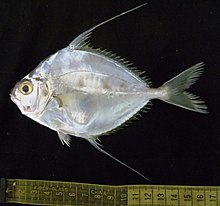| Leiognathus longispinis | |
|---|---|

| |
| Scientific classification | |
| Domain: | Eukaryota |
| Kingdom: | Animalia |
| Phylum: | Chordata |
| Class: | Actinopterygii |
| Order: | Acanthuriformes |
| Family: | Leiognathidae |
| Genus: | Leiognathus |
| Species: | L. longispinis |
| Binomial name | |
| Leiognathus longispinis (Valenciennes, 1835) | |
| Synonyms | |
Leiognathus longispinis, commonly known as the longspine- or Smithurst's ponyfish, is a fish of brackish and marine waters found in the Indian and western Pacific Oceans, from India through Malaysia and Indonesia south to northern Australia and east to the Philippines and Fiji It was described in 1835 by French Zoologist Achille Valenciennes from a specimen caught off Waigeo island in Irian Jaya in New Guinea. In 1886 Ramsay and Ogilby described what turned out to the same species from Hood Lagoon in Papua New Guinea, naming it Leiognathus smithursti. In 2008, ichthyologists Prosanta Chakrabarty and John S. Sparks resurrected the genus Aurigequula and placed L. longispinis and L. fasciatus in it, on the basis of a horizontal row of yellow markings on their flanks and elongated second spine of the dorsal fin. However, a molecular study showed that the genus Leiognathus was nested within Aurigequula, and hence the genera were merged once more. Fishbase places this species in Leiognathus while retaining the striped ponyfish (Aurigequula fasciata) in the monotypic Aurigequula.
The longspine ponyfish reaches a total length of 16 cm (6+1⁄4 in). It is distinguished by a long spine on both its dorsal and anal fin.
Found to depths of around 40 m (130 ft), the longspine ponyfish forages on the sea floor, generally in murky environs, consuming fish, crustaceans, arrow worms, nematodes, and shellfish such as bivalves, and gastropods.
Like all members of the ponyfish family, the longspine ponyfish is bioluminescent. The ventral surface glows, which is thought to provide camouflage and confuse predators.
References
- ^ Froese, Rainer; Pauly, Daniel (eds.). "Leiognathus longispinis". FishBase. July 2015 version.
- Eschmeyer, William N.; Fricke, Ron & van der Laan, Richard (eds.). "Species in the genus Aurigequula". Catalog of Fishes. California Academy of Sciences. Retrieved 18 November 2020.
- Sparks, John S. (2006). "Leiognathus longispinis (Valenciennes, in Cuvier and Valenciennes, 1835), a Senior Synonym of Leiognathus smithursti (Ramsay and Ogilby, 1886) (Teleostei: Leiognathidae)". Copeia. 2006 (3): 539–43. doi:10.1643/0045-8511(2006)2006[539:llvica]2.0.co;2. JSTOR 4098718.
- Seah,Y. G.; Usup, Gires; Mohamed, Che Abd Rahim; Arshad, Aziz Bin; Ghaffar, Mazlan Abd (2012). "Phylogeny and morphological delineation of leiognathids in the waters of Peninsular Malaysia" (PDF). Coastal Marine Science. 35 (1): 91–95.
- ^ Allen, Gerald R. (2009). Field Guide to Marine Fishes of Tropical Australia. Perth, Western Australia: Western Australian Museum. p. 118. ISBN 9781920843892.
- ^ Sparks, John S.; Dunlap, Paul V.; Smith, Leo (2005). "Evolution and diversification of a sexually dimorphic luminescent system in ponyfishes (Teleostei: Leiognathidae), including diagnoses for two new genera" (PDF). Cladistics. 21 (4): 305–27. doi:10.1111/j.1096-0031.2005.00067.x. hdl:2027.42/72092. PMID 34892969. S2CID 53063530.
| Taxon identifiers | |
|---|---|
| Leiognathus longispinis | |